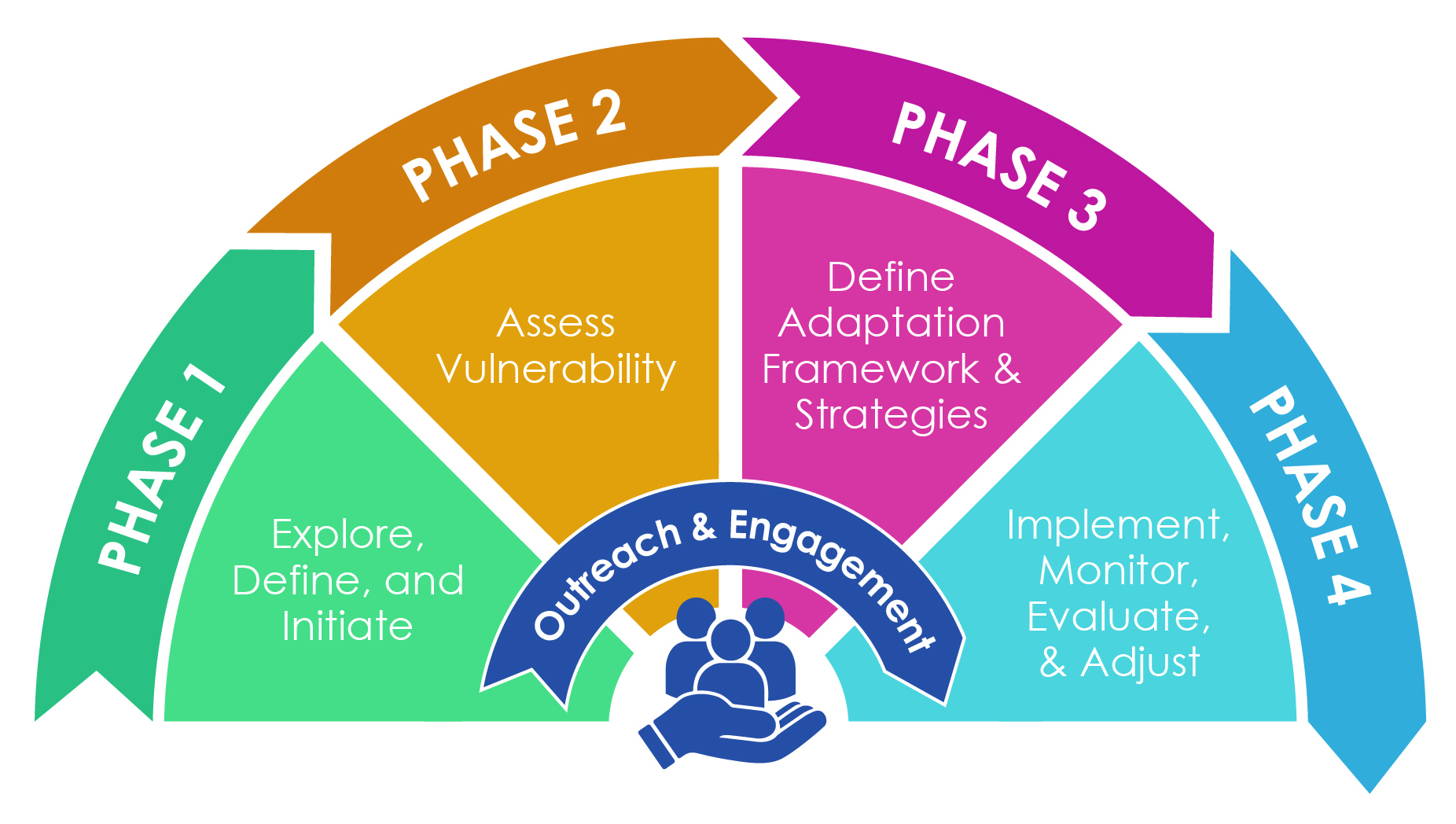The Adaptation Planning Guide provides guidance to local governments on local adaptation and resiliency planning.
- A step-by-step process that communities can use to plan for climate change
- Designed to be flexible and responsive to community needs
- A summary of statewide guidance, resources and tools
- Updated from the 2012 original to reflect 2020 best practices, best available science, and the latest updates to state plans, policies, programs and regulations
- Equity and community engagement integrated throughout all planning phases
- Download the APG brochure for some quick facts on using the APG
Adaptation and resilience are not the same thing, although they are related.
According to the State’s Planning and Investing for a Resilient California guidebook, Adaptation is “an adjustment in natural or human systems to a new or changing environment” (such as the increased frequency and intensity of climate-related hazards or other climate-related conditions). An adaptation adjustment “moderates harm or exploits beneficial opportunities” brought about by the change.
Resilience is “the capacity of any entity—an individual, a community, an organization, or a natural system—to prepare for disruptions, to recover from shocks and stresses, and to adapt and grow from a disruptive experience.” A community’s resilience is determined by its ability to survive, adapt, and thrive no matter what acute shock or chronic stressor it experiences.
California Government Code § 65302 was amended by SB 379 and SB 1035 to require that local cities and counties include climate adaptation and resiliency and new information relating to flood and fire hazards in the safety element of their general plans.
In 2015, SB 379 revised § 65302(g)(4) to require that cities and counties update their safety elements to address climate adaptation and resiliency strategies applicable to their jurisdiction. The updates are required at the next update of their local hazard mitigation plan (LHMP) on or after January 1, 2017. Local jurisdictions without an LHMP must update their safety elements beginning on or before January 1, 2022. The safety element update must include:
- A vulnerability assessment identifying the risks that climate change poses to the local jurisdiction.
- A set of goals, policies, and objectives based on a vulnerability assessment for the protection of the community.
- A set of feasible implementation strategies to carry out the goals, policies, and objectives.
Addressing climate change relies on two high-level approaches: mitigation and adaptation. Communities should take advantage of strategies that support both goals. For example, homes that install solar panels and battery storage systems are better protected against climate-related disruptions to the electricity supply (an adaptation effort), but solar panels also generate electricity without any GHGs and allow homes to use less energy from GHG-emitting power plants (a mitigation effort). However, there is potential for conflict. Consider a program to install air conditioning systems in homes. While this will help protect residents against extreme heat (an adaptation effort), these systems will require more energy to run and could increase GHG emissions if the energy source is not carbon-free (working against mitigation efforts).
State law requires communities to address GHG emissions (and reductions) in local planning and environmental review processes and climate adaptation in local long-range planning processes, such as general plans (or acceptable alternatives). Communities should evaluate their specific needs and priorities when deciding how best to balance these strategies. Communities can prepare one stand-alone plan to address GHG reduction and climate adaptation, prepare separate stand-alone plans for each topic, or integrate the topics into other plans and planning processes. While there are numerous co-benefits between climate adaptation and GHG reduction, there are also instances where there may be trade-offs. These trade-offs should be considered and balanced in the context of a broader planning framework that addresses community goals and needs. It is essential to reduce emissions and plan for impacts simultaneously because efforts to adapt will be overwhelmed by the harm done by climate change if emissions are not reduced.
Equity means that all people are justly and fairly included in society and that everyone is able to participate, prosper, and achieve their full potential. It recognizes that everyone enjoys different advantages and faces different challenges, and that everyone should be treated justly and fairly according to their circumstances. Equity should be treated as a critical component of all planning, including climate adaptation planning. Equitable climate adaptation planning involves identifying persons who may be most vulnerable to climate change and ensuring that planning processes, distribution of resources, and efforts to address systemic wrongs are all conducted in an equitable manner.
Communities have a range of possibilities for taking action on climate change adaptation. Some common municipal plans and programs include:
- Administrative policy, procedures, and initiatives
- Climate action plan (CAP)/climate change action plan / climate adaptation plan / climate adaptation and resilience plan / climate mitigation and adaptation plan
- General plan, comprehensive plan, community specific plan, or community area plan
- Local hazard mitigation plan
- Zoning code and other land development codes, ordinances, and resolutions
- Local coastal program (LCP)
- Capital improvement plan/program
- Integrated regional water management plan
- Emergency operations plan
- Tribal and indigenous community plans
- Community health assessments and community health improvement plans
- Historic or cultural preservation plans
The four phase planning process and guidance presented in this APG support integration of climate adaptation into multiple plans and programs.
Explore Adaptation Planning Phases
Explore Supporting Resources
Adaptation Planning Resources
Adaptation Pathways
Explore by Topic


